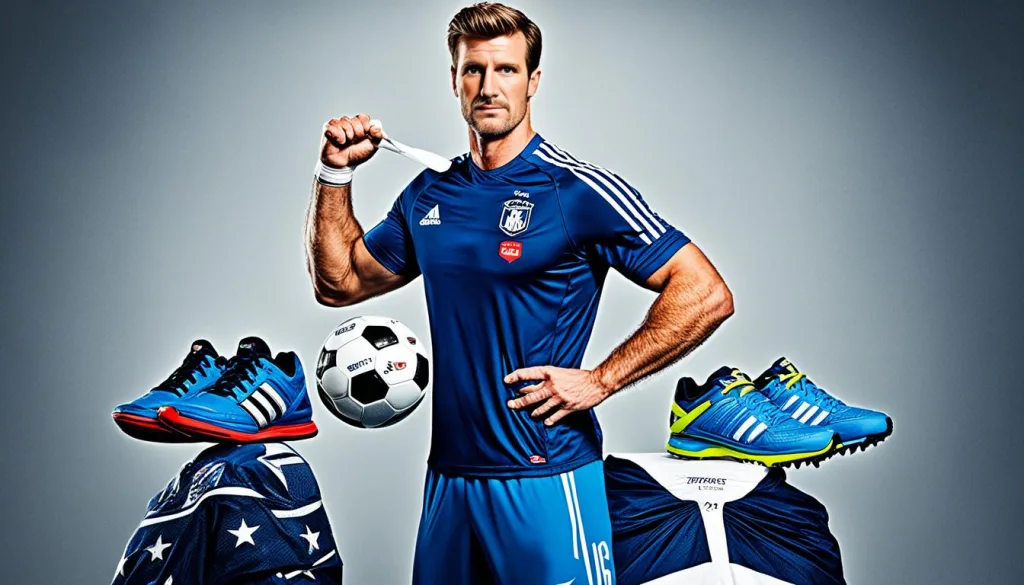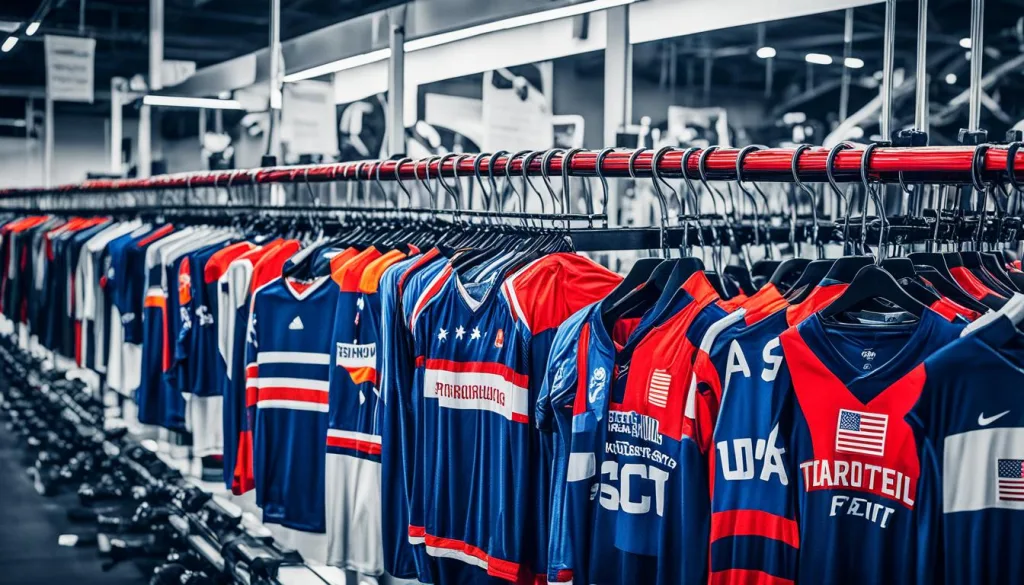How Tariff Changes Impact Sportswear Pricing and Compliance
Connect With Us Today
Consider us for your next production run. Why wait? Send us your questions here.
Tariff changes have a big impact on sportswear pricing and compliance. They shape an industry linked closely with global trade and market trends. Manufacturers with strong tariff plans can cut their costs by almost 59%1. This shows how sportswear companies are smart in dealing with trade changes. With the U.S. Trade Representative (USTR) looking at tariff exclusions, firms need to be flexible. They must keep up with compliance and pricing strategies1. It’s key for stakeholders to understand these changes to keep their businesses competitive and sustainable.
Key Takeaways
- Companies are using strategies to reduce the tariff impact on costs and pricing1.
- It’s crucial to stay updated with USTR’s decisions for staying compliant in the sportswear industry1.
- Duty drawback provisions offer big financial recovery chances for exporting companies1.
- Being informed on different market-specific taxes and fees, like those in U.S. territories, is important for proper sportswear pricing2.
- Using free trade agreements and tax exemptions can help improve sportswear shipment costs and pricing2.
- Knowing different duty and tax rates across countries is key for competitive global sportswear pricing2.
Understanding the Global Sportswear Market and Trade Policies

The global sportswear market is shaped by trade policies. These policies affect the world scene and the financial health of sportswear manufacturers. Knowing how market forces and rules interact is key for those wanting to succeed in international trade.
Traversal of Sportswear in International Trade
Trade policies, like tariffs and trade deals, greatly impact the sportswear sector. In South Africa, tariff rates dropped from over 20 percent to 7.1 percent in 20203. Yet, the tariffs on imports like apparel, fabric, yarn, and fibers remain high3. This affects the global movement of sportswear products.
Also, firms are changing how they make and get products due to new trade rules. For example, facing new tariffs on goods from China, retailers such as Best Buy, Macy’s, and Home Depot are finding ways to lessen tariff effects. They might move factories or suppliers out of China4.
The Direct Effect of Tariffs on Sportswear Manufacturers
Tariffs directly hit sportswear producers, changing how much things cost to make and sell. To deal with higher costs, companies might change prices. This can influence what people buy and the overall market demand. Brands are finding clever ways to avoid tariffs, like making silk T-shirts instead4. They also plan shipping carefully to dodge tariffs4.
Tariffs have always affected companies making clothes and shoes. This was true even before President Trump4. Despite strategies to handle these tariffs, businesses still face higher expenses. This shows the need for new ideas and quick action in dealing with international trade rules4.
| Region | Tariffs on Apparel Imports | Impact Strategies |
|---|---|---|
| South Africa | 40% (finished goods) 30% (fabrics) 22% (yarns) 15% (fibers) |
Rebates for domestic manufacturing materials3 |
| China (US imports) | 15% on apparel, textiles, footwear starting Sept 1st4 | Factory relocation, product adjustments, advanced shipping4 |
The Ripple Effect of Tariff Adjustments on Production Costs
The sportswear industry’s structure is complicated. Tariff adjustments affect every part of production costs. Changes in tariffs bring big ripple effects, changing material, making, and moving costs. It’s vital for those involved to understand how these changes affect costs and plan accordingly.

A slight change in tariffs can significantly raise production costs. The price of raw materials may increase. This could lead to changes in where companies get their materials or in their contracts to stay competitive.
It’s not just about passing on costs. It’s about creating a plan that uses efficient making methods, cost-effective sources, and quick changes to market shifts.
In the making area, tariff adjustments have a big impact too. With higher tariffs, companies might need to make their operations more efficient, use new technologies, or find cheaper labor sources. Balancing tariffs requires a careful mix of keeping quality high and costs low.
- Innovating manufacturing techniques to reduce costs
- Exploring tax incentives for production efficiency
- Investing in automation to decrease dependency on manpower
Transportation costs also go up with higher tariffs. These increased shipping expenses must be smartly managed to avoid affecting prices for consumers. Wise manufacturers negotiate better shipping deals or use different ways to send their products.
| Tariff Impact Area | Challenges | Strategies |
|---|---|---|
| Cost of Materials | Increase in raw material pricing | Supplier renegotiations, alternative sourcing |
| Manufacturing Processes | Need for efficient production methods | Technological investments, process optimization |
| Transportation Expenses | Rising transportation and shipping costs | Logistics negotiations, distribution channel diversification |
Sportswear Tariffs: A Complicated Web of Compliance
The sportswear industry faces challenges in a dynamic global market. Following tariff guidelines is key for brands. It helps them stay competitive and avoid legal issues.
An Overview of Sportswear Tariff Guidelines and Regulations
Tariff Preference Levels (TPLs) are essential for sportswear brands. For example, Bahrain had a TPL that allowed imports of fabric up to 65 million square meters from 2006 to 20165. Countries like Nicaragua and Oman also had specific caps for imports. These tariff rules are complex, so brands must pay close attention.
Strategies for Sportswear Brands to Navigate Tariff Changes
Sportswear brands are finding ways to deal with these regulations. Diversifying where they get their materials is one strategy. Morocco used a TPL to grow its share in the U.S. market from 2006 to 20155. Opting for sustainable practices helps reduce the impact of trade changes. This means local sourcing and less transportation. For brands wanting to succeed in the U.S., these moves are crucial.
Trade data shows how brands need to be smart with TPLs. For instance, Costa Rica had a special limit for wool and swimwear up to 20185. This highlights the different strategies needed for various sportswear items.
In conclusion, dealing with sportswear tariffs is complex but can be beneficial. Brands that understand tariff guidelines and adapt can successfully expand globally. Making informed choices allows them to navigate risks and seize opportunities.
How Tariff Changes Impact Sportswear Pricing and Compliance
Global trade is always changing, and so are tariff impacts on the sportswear industry. These changes affect sportswear prices and trade rule compliance. It’s important for businesses to keep up with these changes to stay profitable and legal.
Looking at tariffs and sportswear costs, there’s a clear link. Using the Customs Info Database to check duties in over 170 markets helps. This shows how global the sportswear business is and why knowing about tariffs matters for pricing.
The U.S. has trade deals with 20 countries allowing tax-free entry for American goods. But, sticking to these agreements’ rules can be tricky. Brands might need to change their supply chains to use these tax breaks.
Explore comprehensive trade resourcesUseful resources give deep insights into tariff rules. They help make better choices about pricing and following trade laws.
In places like the European Union, the EU Taric database shares tariff info for its 27 member countries2. This info is key for deciding on sportswear pricing, as tariffs add extra costs to retail prices.
Looking at fees in Guam and Puerto Rico helps companies adjust their prices for these markets2. Knowing about special tax breaks, like for shipments to the USVI, is also critical for setting clear prices and following rules2.
The U.S. territories, including Puerto Rico, Guam, and the U.S. Virgin Islands, influence tariffs and sportswear pricing2. Businesses must understand each place’s taxes to avoid high costs or penalties for rule-breaking.
Tariff changes are complex, affecting sportswear prices and rules. Manufacturers and brands need to update their plans to keep up with these changes. This helps them stay competitive and follow the law in the global sportswear market.
Conclusion
We’ve looked deeply into how tariffs on sportswear affect their prices and rules. We saw that companies need smart strategies to handle changing trade rules and tariffs. They do this to keep prices fair and follow tight rules. This shows their grit and clever planning. The global sportswear market is a web where any policy change affects everything from making products to selling them.
In the U.S.-Morocco and U.S.-Singapore FTAs, the TPL limits began high but got smaller over time. For Morocco, it was 30 million SMEs and for Singapore, 25 million. This shows a planned way to apply tariffs in these places5. With TPL limits, like 50 million for Oman and 65 million for Bahrain, it helps control trade and keep the U.S. market competitive5. When some TPLs ended, it changed trade with countries like Bahrain, Nicaragua, and Costa Rica5.
The key takeaway is being smart and quick to adapt. Staying ahead in the sportswear market means knowing how to deal with tariff changes. Watching TPL limits change, from 4.285 to 30 million SMEs for places like Morocco, shows its effect on prices and rules5. Sportswear companies must use their deep understanding of the market to deal with global trade shifts.
FAQ
How do tariff changes impact sportswear pricing?
What is compliance with tariff regulations in the sportswear industry?
How do tariff changes affect sportswear manufacturers?
What strategies can sportswear brands employ to navigate tariff changes?
Why is compliance with tariff regulations important for sportswear brands?
Source Links
- https://www.journalofaccountancy.com/news/2020/jan/tariffs-trade-war-tips-for-cpas-22557.html
- https://www.trade.gov/import-tariffs-fees-overview-and-resources
- https://www.trade.gov/country-commercial-guides/south-africa-import-tariffs
- https://www.cnbc.com/2019/08/30/92percent-of-apparel-from-china-will-be-hit-with-tariffs-sundayhow-retailers-are-coping.html
- https://www.usitc.gov/publications/332/working_papers/id_18_053.html
Latest News
How Collaboration Shapes Consumer Preferences in Sportswear
Navigating Consumer Rights and Warranties in Sportswear Sales
Artificial Intelligence in Fashion Forecasting and Trend Analysis
The Shift Towards Inclusive Sizing in Sportswear: Consumer Reactions
The Global Expansion of Luxury Sportswear Brands
From Sketch to Gym: The Design Process of Fashionable Sportswear
Understanding the Role of Trade Associations in Sportswear Compliance
How Economic Trends Influence Consumer Spending on Sportswear
Learning from Successful Global Market Entries
Best Practices for Managing Cross-Cultural Teams
Using Technology to Fight Counterfeit Fashion Products
Carbon Nanotube Fabrics for Superior Strength and Flexibility
The Growth of Fitness Tracking Apparel in Health and Wellness
Exploring the Influence of Social Proof in Sportswear Purchasing
Strategies for Managing Compliance in a Multinational Operation
Trends in Global Footwear: Performance Meets Lifestyle
The Role of Artificial Intelligence in Tracking Supply Chain Operations
Evaluating the Success of Sportswear Collaborative Projects
Evaluating the Potential of Emerging Markets
Global Shifts Towards Gender-Neutral Sportswear
Share This Article
Latest Articles



















